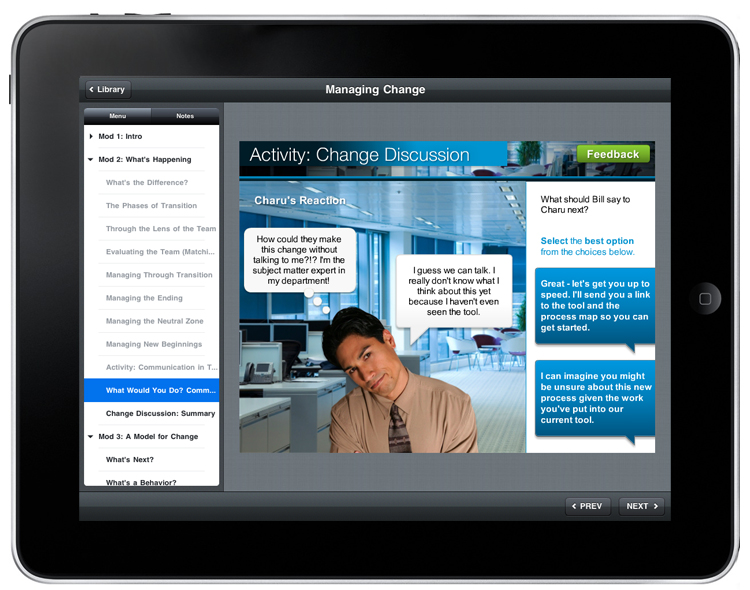Your company has a new five step leadership model it wants everyone to follow… and you need to make an eLearning course to get the ball rolling. Unfortunately, employees are not too enthusiastic about the new model and don’t see any benefit to themselves if they start using it. Is eLearning going to solve the problem?
Or perhaps you need to help sales reps practice their selling skills. Should be simple enough, except some of the new reps are fresh out of college, and others are 15 year veterans who come from another organization and are used to doing things “their way.” You’ve been asked to create eLearning for that, too. How do you make it applicable to everyone?
Why is teaching soft skills so hard?

I interviewed Alicia Ostermeier, Manager of Operations and former Senior Learning Designer at BLP, to learn more about how she approaches eLearning projects designed to teach soft skills. Alicia has developed training on sales skills, leadership skills, communication skills, change management and more.
Read on to learn more about developing soft skills eLearning… that actually works.
Starting a Soft Skills eLearning Project
If a client comes to us with a new model they want everyone to follow, we know it’s not really about the model, but a desired performance improvement. Alicia uses a set of questions that we like to use across BLP to kick off new projects.
Alicia commonly asks these questions:
- “Okay, that’s the model you want to teach, but what do you want people to do with it?”
- “What’s in your environment right now that’s driving a need to change the way you do things?”
- “What do you expect to happen differently after you’re done? What will people be able to do?”
- “What other mechanisms will be in place to help them get it done? Job aids? Organizational culture change?”
- “Who is the actual learner? Are they new to the company or have the been around awhile?”
- “What”s the mood of people taking the course? Will change be perceived as good or bad?”
Answering basic questions like these BEFORE starting the eLearning project are crucial to success.
Choosing the Right Learner Interactions

Of all the interactions available to eLearning designers, Alicia rates scenarios as the most effective tool for soft skills eLearning. Learners need to see what a particular model for soft skills behavior looks like in real life. The best eLearning scenarios will do the following:
Allow learners to make decisions: Include realistic consequences. Let learners experiment with various responses to see how the outcome is affected. Scenarios in eLearning let people practice in a safe environment. One of Alicia’s preferred scenario types asks learners to have a conversation with a co-worker where they not only get to see what the co-worker says, but also what they are thinking. Get creative with your scenarios to help learners practice.
Include appropriate context and background information: Alicia cautioned that scenarios that do not set the stage and give learners the “what” and “why” will be less effective than scenarios that provide a sense of context.
Apply directly to the learner’s job: Your scenarios have to seem realistic. Trying to keep things generic just won’t have a lasting impact. When multiple job roles and personas are taking a course, Alicia recommends using a branching scenario that presents different learners with the most applicable information for them.
Develop Emotional Intelligence and Intuition: Since soft skills training often uses a particular “5 step model” or “4 step tool” to provide guidance for learners, eLearning scenarios must be designed to show that one sizes does not fit all. Your goal should not be teaching people to go down a flow chart and make the best decision, unless you will have a flow chart available in real life! According to Alicia:
The trick is to not make it about the model itself, but about how the model applies in the particular business situation. It has to apply to the level of employee you are working with and types of individuals on your team.
Without a doubt, effective soft skills training will include lots of applicable scenarios… giving learners a chance to practice. As Alicia (rather humorously) puts it, “You can fail at your desk in eLearning and you haven’t hurt anything.”
Tangible Impact of Soft Skills eLearning

Soft-skills eLearning is most useful for giving learners a standardized picture of “what good looks like” and giving them some introductory practice opportunities. And while soft skills eLearning is an important tool in a company’s culture, Alicia says it is only one part of the solution:
For soft skills training to work, the entire framework has to be there, including the support of management. Learners must feel like there is organizational support for what they’re doing… and have the right tools and resources.
The best soft skills training curriculum will take a blended approach. Alicia recommends combining eLearning with face to place role playing and one on one coaching. Have Director-level people sit in and observe the role-playing to encourage greater accountability. Integrate the training into what people are already doing in their workday anyway if you can.
If you follow Alicia’s advice, Soft Skills training does not have to be hard. Remember: use eLearning to show what “good” looks like, include lots of scenarios, and blend the eLearning with role playing and coaching opportunities. Don’t forget that soft skills success depends on commitment and buy-in from the organization as a whole. eLearning plays a big part, but it’s still just one piece of the puzzle when it comes to improving performance.




Thank you for a very useful article. http://www.ectraining.co.za